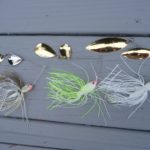
When do you use which blades, trailers, etc.?
For many fishermen, spinnerbaits have taken a back seat to a lot of new lures and trends in fishing: swimbaits, umbrella rigs, vibrating jigs and swim jigs. All are excellent lures and have replaced a spinnerbait for many fishermen.
While all lures have a specific time and place they work the best, it is a mistake to abandon spinnerbaits. I’ve noticed that not that much is even written about them anymore. So as a refresher to the advanced anglers and instruction to new anglers, I’ll break down how I see spinnerbaits fitting in to your tackle box.
Let’s talk percentages. I’d say a spinnerbait is the absolute best bait to fish for bass about five percent of the time, but it can literally work 365 days a year if you fished it. That five percent is when it’s the best, it’s so powerful and deadly on bass that I dedicate at least one rod to a spinnerbait nearly every time I go fishing — just in case. A spinnerbait can work in virtually any condition, but I’ll stick with it as the best for only five percent of the time. A perfect scenario could even arise for a short time on any given day, so be prepared.
More percentages: a spinnerbait can literally cover hundreds of miles of water in a day, thus increasing your odds of encountering feeding fish. Depth is a limiting factor, but you can adjust speed and depth issues with blade size, head weight and line type and size. The larger the blades, the more lift it will have and the slower it will run. Smaller blades and heavy heads allow speed and depth changes. Heavier weight also lets the bait go deeper and/or faster. You can go to www.davestournamenttackle.com to get a good idea of the vast amount of options available. They even have one designed for super-deep water, a 1 1/2-ounce bait called the “Bullseye” that is deadly on bass in deep water since they don’t see many spinnerbaits down there.
Finding the perfect spinnerbait for each situation is crucial; one style will not do everything, so I advise some experimentation to see what works for you.
Best-case scenario: pre-frontal, breezy, southwest wind during the prespawn — the perfect set up for a spinnerbait. Honorable mention would come in the fall when water temperatures fall into the low 60s and bass are keying on shad in shallow water.
Cover: a spinnerbait arguably comes through cover better than any other lure, making it easy since bass spend most of their time in and around cover and you don’t want to spend all day hung up.
Water clarity: Spinnerbaits work in every color water I’ve ever encountered. I’ve caught fish in zero visibility, and I’ve also caught fish where you could see the bottom at 20 feet. The basic rule of thumb here is a natural-colored bait with smaller blades is better in clear water, and louder colors and larger blades are better in muddy water.
Blade styles: Colorado, willow-leaf and Indiana are the most common. Colorado blades are the round ones that put out the most vibration and are better for stained or muddy water. Willow-leaf blades, shaped like a willow leaf, are best for clearer water as they have the least resistance and allow faster retrieves. Indiana is a cross between the two and tends to be best in stained water. It is important to understand that any of these blades can catch bass in any water condition, but use what I’ve suggested as a starting point. A deep-cut blade has less vibration than a flat one, so it is possible to get as much or more vibration out of a flat willow-than a cupped Colorado blade.
Rod and reel: I like a 7-foot MH Daiwa Steez Rod and 6.3:1 Steez or Zillion reel for fishing it slow and a 7.1:1 for burning it.
Trailers: Rick Clunn taught me the power of a big trailer to discourage small fish from biting it in a tournament situation. He put a full 10-inch worm on the back. I’ve had good luck with a 7-inch shad colored Culrpit Fat Max as a trailer, but I find myself these days not wanting to discourage anything from biting, so most of the time I go with no trailer.
Line: I like 14-pound Sunline Sniper for long casts, burning small baits or deep water and 20-pound Sniper for shallow, heavy cover/big bass fishing.
If you haven’t tried spinnerbaits for a while, I encourage you to try them again, and always be on the lookout for that magic five percent when the spinnerbait fishing is at its best.





Be the first to comment